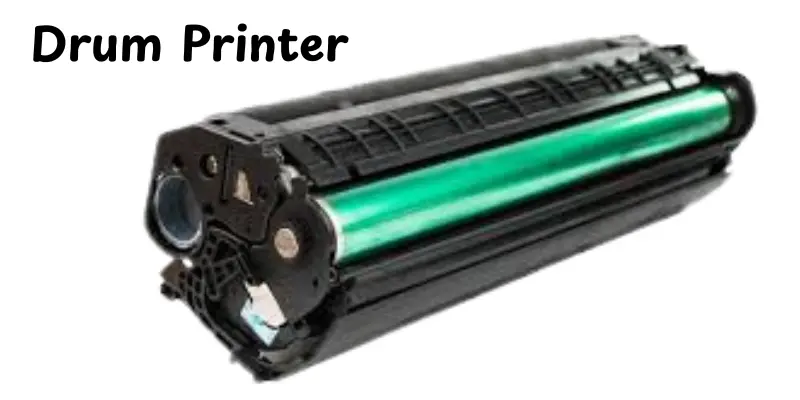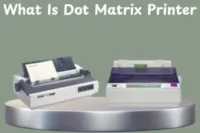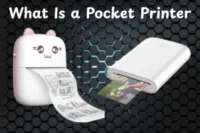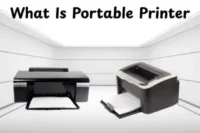What Is Drum Printer? Discover How It Really Works
Published: 18 Oct 2025
Have you ever wondered how early printers could produce pages quickly before modern machines took over? That’s where the drum printer comes in. It could appear old-fashioned, but it has an important effect on modern printing technology. In this article, you’ll learn about drum printers, how they function, their key benefits and drawbacks, and why they’re still useful in certain sectors today. By the end, you’ll understand how this classic printer transformed the way we print.
What Is a Drum Printer?
A drum printer is an early type of impact printer that produces text and characters onto a rotating metal drum. The drum has high characters set in designs, and as it spins, the printer presses inked ribbons against paper to generate the print. Each rotation shows a complete line of text at once. This made it more quickly than earlier character-by-character printers. Drum printers were commonly used in data centers and offices for large-scale printing activities. They are recognized for their speed, strength, and power.

History of Drum Printer
The drum printer first invented in the 1950s and gained popularity during the 1960s and 1970s. Companies such as IBM and CDC designed them for mainframe computers to handle large print tasks. These printers were useful in banks, research labs, and government offices for producing speedy data reports. They provided amazing time efficiency and supported the automation of business document printing. However, they stopped when laser and inkjet printers came, providing less noisy, simpler, and more flexible printing options.
How a Drum Printer Works
A drum printer works on the basic principle of printing one whole line at a time using a fast-rotating drum. It is designed for speed and is used in situations where large amounts of text must be created fast. Here’s how it works, step by step:
- The drum’s surface is carved with characters set in many columns.
- As the drum rotates, it passes in front of a row of hammers covered by the paper.
- Each hammer matches a specific print location on the paper.
- When the right shape on the drum connects with the hammer, it strikes the paper with an ink ribbon.
- The impact transfers ink from the ribbon to the paper, creating a single complete line almost instantly.
- This technique is repeated while the drum rotates, resulting in continuous lines of text at high speed.
Key Parts of a Drum Printer
A drum printer has many main parts that work together to print fast and accurately. Each component plays an important role in the printing process. Here are the key parts:
- Print Drum: A rotating cylinder that contains written characters used in printing.
- Hammers and Magnets: Strike the paper at the right time to print the correct character.
- Ink Ribbon: Transfers ink to the paper when struck by the hammer.
- Paper Feed Mechanism: Moves the paper upward after each printed line.
- Control Unit: Manages timing and coordinates all printing actions.
- Buffer Memory: Stores a full line of data before it’s printed on paper.
Types of Drum Printer
There are many types of print drums, depending on how they are built and used for printing. Each type has a unique design that improves speed, accuracy, and print quality. Here are the main types explained simply:
- Cylindrical Drum: The most popular type, with letters written around the surface for quick line printing.
- Segmented Drum: The drum is divided into small portions, each of which prints a particular part of the line.
- Interchangeable Drum: Users may simply replace the drum with other styles or character sets.
- Customized Drum: Designed specifically for sectors that require unique symbols or specific writing styles.
Applications of drum printer
Drum printers were more used in situations where rapid and continuous printing was important. They managed large volumes of data and reports before modern printers took over. Here are some of their common applications:
- Data Centers: Used for printing large system reports and transaction logs quickly.
- Banks and Financial Institutions: Helped in generating daily statements and customer records.
- Government Offices: Printed bulk administrative documents and payroll lists.
- Industrial Settings: Used to produce continuous logs and production summaries.
- Universities and Research Labs: Printed research data and large batches of academic reports.
- Billing Departments: Ideal for printing invoices, bills, and receipts in large quantities.
Drum Printer vs Other Line Printers
Drum printers and other line printers work on similar principles but differ in design, speed, and print style. Let’s look at how they compare in a simple way:
| Feature | Drum Printer | Chain Printer | Band Printer | Bar Printer |
| Printing Method | Uses a rotating drum with engraved characters | Uses a moving chain of characters | Uses a flexible band with letters | Uses pins or bars to print a full line |
| Speed | Moderate to high | Faster than drum | Very fast | Moderate |
| Print Quality | Clear and consistent | Good but slightly variable | High quality | Fair |
| Noise Level | Quite noisy | Noisy | Quieter | Moderate |
| Maintenance | Needs drum alignment | Requires chain tensioning | Easier to maintain | Needs pin replacement |
| Common Use | Reports, bills, data logs | High-speed business reports | Bank and data centers | Simple line printing |
Advantages and Disadvantages of Drum Printer
In this section, we’ll look at the main pros and cons of a drum printer. Knowing both sides helps you decide if it suits your printing needs, especially for large or fast document tasks.
| Advantages of Drum Printer |
|---|
|
| Disadvantages of Drum Printer |
|---|
|
Maintenance Tips
Taking care of a drum printer helps it last longer and work smoothly. Regular cleaning and proper handling can prevent printing errors and costly repairs. Here are some simple maintenance tips to follow:
- Clean the Drum Regularly: Wipe off dust and ink buildup to keep prints clear and sharp.
- Check the Ink Ribbon: Replace the ribbon when prints start to fade or look uneven.
- Inspect Hammers and Magnets: Make sure they’re clean and not jammed for consistent printing.
- Keep the Paper Path Clear: Remove any paper bits or debris to avoid paper jams.
- Avoid Overheating: Let the printer cool after long use to protect internal parts.
- Schedule Regular Servicing: Get it checked by a technician to maintain performance and prevent breakdowns.
What to Check Before Buying
Before buying a drum printer, it’s smart to know what features really count. A quick check of these key points can help you pick the right and reliable model.here are some tips:
- Print Speed (Lines Per Minute): Drum printers are made for high volume. Pick one with high speed if you’ll print many lines often.
- Drum Condition or Model: Used drum printers need a drum in good shape. Worn drums cause blurry prints.
- Ribbon Supply: Check if ribbons are still sold for the model you want. If ribbons are rare or too costly, maintenance will be hard.
- Font or Character Set Options: Some drums have fixed characters. If you need special fonts or symbols, get a model that supports changing or interchangeable drums.
- Noise & Environment: Drum printers are loud. If you’ll use it in a shared or quiet space, ensure enough sound insulation or a noise-reduced version.
- Size & Paper Feed: Drum printers are large and need space. Also check if it handles the paper size and types you regularly use.
- Interface / Connectivity: Older models may use parallel or serial ports. Make sure it can connect to your current systems (USB, network, or appropriate adapters).
- Spare Parts Availability: Check if parts like hammers, magnets, and the drum itself are still made or stocked.
- Support & Warranty (if new or refurbished): See if there’s any warranty or repair support. A printer with good support can last much longer.
Conclusion
So, guys, in this article, we’ve looked over the drum printer in detail, including what it is, how it works, its basic parts, kinds, pros and cons, uses, and even buying advice. You have seen why it was once a printing technology powerful and why it’s still important in some sectors today.If you ever need a powerful, fast, and reliable printer for bulk work, a drum printer is worth considering. It may be old school, but its quality and reliability are unequaled.Keep learning, and remain tuned for more helpful guides that make technology simple and enjoyable!
FAQs
A drum printer is mainly used for high-speed text printing in offices, banks, and data centers. It handles large volumes of reports, invoices, and records quickly. It’s ideal when speed and reliability matter more than design or graphics.
Drum printers are very fast and can print hundreds to thousands of lines per minute. Their speed makes them perfect for bulk printing jobs. They are much faster than most regular printers.
No, drum printers are made for text printing only. They can’t print images, charts, or complex designs. Their main strength is speed, not visual detail.
Yes, they are still used in some large organizations and data centers. Many companies prefer them for bulk and continuous printing tasks. However, modern printers have replaced them in most offices.
Yes, a drum printer is a type of line printer. It prints one full line of text at a time instead of single characters. This is what makes it so fast.
Yes, when the print quality decreases or the lines become thin, it is time to change the drum. A broken drum affects written clarity. Replacing it will keep your printouts bright and clean.
Yes, it is an impact printer because it uses hammers to hit the ink ribbon against the paper. This impact action creates the written text. It works similarly to a typewriter, but on a bigger size.

- Be Respectful
- Stay Relevant
- Stay Positive
- True Feedback
- Encourage Discussion
- Avoid Spamming
- No Fake News
- Don't Copy-Paste
- No Personal Attacks

- Be Respectful
- Stay Relevant
- Stay Positive
- True Feedback
- Encourage Discussion
- Avoid Spamming
- No Fake News
- Don't Copy-Paste
- No Personal Attacks





